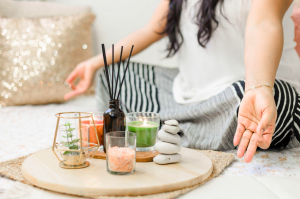
In recent years, you may have heard people talking about mindfulness; it has become a mental health and wellness buzzword. Maybe it’s people you know, or maybe you’ve seen social media posts or news stories about mindfulness and the importance of being mindful. You may not have heard what mindfulness truly is and how it can benefit you and your state of mind. When you think of mindfulness, you may think of someone sitting in the lotus position, breathing deeply and thinking no thoughts.
Through meditation (which may or may not include reduced thoughts) is a great way to check in with yourself and stay mindful; it is a tool, not the end result. Mindfulness allows us to stay tuned in to what is happening in our life moment-to-moment, which opens the door for more genuine connection and emotion, more joy, and more life.
What is Mindfulness?
Mindfulness is being in the present moment non-judgmentally. It is having the awareness to lean into our experiences and describe our experiences without attaching meaning to them. When we are mindful, we are tuned into how we are feeling, what we are thinking, and what we are saying. This allows us to make a note of emotional triggers; escalating levels of discomfort, anger, or sadness; events and circumstances that spark joy; and a myriad of other information that can improve how we live our lives. Mindfulness allows us to exist authentically.
What is it not?
Spoiler alert: it is not just being “zen.” It is also not investigating or analyzing what we are going through. It is simply observing and noticing, and noting. We do not need to fixate and ruminate on our thoughts and feelings to be mindful. In fact, when we become obsessed with these behaviors, we are less likely to note our mental state in real-time and without judgment.
Why do we need it?
Mindfulness is a great way to reduce, avoid or circumvent anxiety and depression. Keeping our thoughts in the present moment enables us to process immediate information, which is often much more straightforward. If we are mentally living in the past or the future, our waking hours can be consumed with panic about things we cannot change. We may find ourselves overwhelmed by our attempts to forecast what is to come. We may also find ourselves staying up at night with insomnia, ruminating on the past, or stressing about the future. Many of us have experienced sleep problems when we lay our heads down at night and the events of the day come rushing to us. Often, if we think about it, we find that the moments we are focusing on are moments we weren’t being mindful in, and something got away from us. It is prevalent among human beings to live in the past or future, but mindfulness brings us back to the present.
What stops you from practicing mindfulness?
1) You “can’t sit still”:

There are many misunderstandings and myths around mindfulness, and one of them is that if you can’t sit still, then you are doing it wrong. Most people assume that because their mind wanders a lot, they are not meant to be practicing mindfulness. “It’s just not for me,” or, “It’s just not who I am.” Again, this idea of settling into a position of meditation and releasing all thoughts from your mind is an image, a representation of a tool that some people use to stay mindful. Meditation is a great relaxation technique but by no means a requirement of practicing mindfulness. There is no need to be stationary while practicing mindfulness.
2) You think that mindfulness and meditation are the same things when they are not:
Meditation is a deliberate practice used to calm and center oneself as part of a mindful way of living and thinking. If you have tried meditation in the past and didn’t enjoy it or didn’t think it “worked for you,” that doesn’t mean that you cannot be mindful in your daily life. (There is also no reason why you cannot revisit meditation in another time and place.) Mindfulness is awareness.
3) You have to have the perfect time and place to practice mindfulness:
This is a similar misconception to the idea that meditation is mindfulness. The truth is that being mindful is a moment-to-moment task, and the best way to achieve it is to simply attempt it as often as possible. Walking down the street, stuck in traffic, conversing with a friend, attending a work meeting, cooking dinner, and more. All are great times to be mindful, to have a self-check-in, and make non-judgmental notes of what you are thinking and feeling. In fact, practicing mindfulness while in less-ideal circumstances is the whole point!
4) Mindfulness feels unproductive or self-centered:
Do you ever think people who practice mindfulness are self-absorbed or too self-centered? Does it make you feel awkward to direct all your attention to your internal experiences? First of all, you should be your number one priority and feel no shame about it. There is no reason that you should feel badly about prioritizing your health and happiness. It is no one’s job but your own, so why not do it well? Beyond your self-care, the person you bring to the world is the sum of your thoughts and actions; caring for yourself helps you to nurture others. In fact, self-awareness facilitates generosity of spirit. It also promotes better communication, as you will choose your words carefully in moments of discussion or conflict. The better you know yourself and the more at peace you are in your mind, the more thoughtful you can be.
Whether you are completely sold on your ability to achieve and/or enjoy mindful living, it cannot hurt to try it out. Even if you set a timer for five minutes a day, in which time you do your best to be mindful of your internal life, you can experience benefits. There are a few ways of practicing mindfulness for better mental health; all you have to do is find what works best for you.
How to practice mindfulness?
1) Staying in the present moment:

There can be some all-or-nothing thinking that happens with this, but there doesn’t need to be. Of course, it is not possible to never think about the past or the future. In fact, reminiscing about happy memories can be very pleasant, and reflecting upon learning experiences from the past can be beneficial. Planning for the future and envisioning your goals and dreams can also be a useful and empowering tool to keep you moving forward in your life. Where thinking about the past or future is tricky is when it is bringing you down or causing worry, so these are the times when you want to do your best to let go of those thoughts. Take a breath, remind yourself that that is not beneficial, and bring your attention back to the present moment. Do this as often and as gently as you can. It will take practice. Sometimes, you will be able to make a conscious plan to stay in the present moment, such as when you mindfully participate in the task at hand. Take the time and make an effort to take action wholeheartedly, whether walking, dancing, or eating. Other thoughts may surface during these tasks; that is to be expected. Acknowledge and release them to the best of your ability.
2) Journaling:
You may find that staying in the present moment is a challenge for you, either because you prefer to multi-task, feel you need to multitask, or are often overcome by intrusive thoughts. Journaling can help you identify your experiences and discover patterns or habits that can ameliorate your ability to stay present or that are making that task difficult for you.
You may want to use prompts for your journaling or play the music that inspires you. You may also want to try free-writing by sitting down and writing without thinking. This can be a great way to vent thoughts and concerns that may become intrusive if you don’t express them.
On the other hand, you might want to try to journal mindfully as practice. There is no rule that says you can’t do a little bit of everything, so long as you are connecting with your inner world and giving yourself space to recognize and acknowledge your thoughts and feelings.
3) Relaxation techniques:
It is much more challenging to stay connected to our thoughts and present in the moment when we are experiencing stress or anger. Our focus on them

perpetuates these negative emotions, and
Small, quick techniques for relaxation can be helpful in spur-of-the-moment incidents, and regular relaxation practice can help maintain a more steady level of relaxation. Both are effective tools for living a more conscious, thoughtful, and deliberate life. Techniques such as deep breathing and progressive muscle relaxation can be employed anywhere at any time. You can also utilize apps like Headspace and Calm to be guided through exercises if you are able to listen to them. Most of us have a little bit of time in the day to listen to guided relaxation exercises; on lunches while commuting while doing the dishes.
4) Gratitude Practice:
You might not think that a gratitude journal can help with mindful living, but when you break it down, you can easily see that gratitude practice can be a bridge to living more mindfully. In order to practice gratitude, we must notice things in our lives to be grateful for. This can help us focus on the present moment and appreciate things going well in our lives. When we discuss living in the past or the future, we are, in essence, discussing a life where the opportunities and blessings in front of us are passing us by. By consciously seeking things to be grateful for, we engage in an action that we take moment-to-moment; we are forced to stay present and to be conscious of what surrounds us.
5) Stay compassionate:
Being mindful and present can become tricky if we are holding judgment about what we think and feel. The idea is not to notice our present moment and judge it, but rather to simply notice and acknowledge it. Compassion is a key ingredient to our mindfulness practice. We must have compassion for ourselves when we notice something we don’t like in our thoughts, emotions, or actions. This doesn’t mean that we let all consideration for others go out the window or that we disconnect from our feelings. This is why it can be tricky to stay mindful, yet so beneficial when it’s done with curiosity and compassion instead of judgment. Having an awareness of ourselves allows us to grow and change, to live at our most content. It doesn’t mean we will never make mistakes or let our emotions get the best of us. But it facilitates awareness that allows us to be our best possible selves more often. To maintain compassion for ourselves, we can practice affirmations, such as: “I am only human, and I don’t have to have all the answers,” or, “I am doing my best,” or, “I am grateful to be learning more about myself.”
Think about the last time you were truly present in a moment of joy. Think about how all you experienced at that time was happiness, and remember how free it felt to let your happiness carry you. This is mindfulness. Think about the last time you were upset or frustrated with someone, but you were careful with your words and stuck to your intent to solve the problem at hand. Remember how productive and respectful you were able to be at that time. This is mindfulness. Mindfulness is a series of decisions to be honest, and attentive. It is not a space of judgment or comparison but one of compassion and self-reflection. You can practice at any time, in any place. You don’t need any special qualifications or permission to do so. Mindful living is your gift to yourself.
Embracing You Therapy Group Practice
Here at Embracing You Therapy, we invite you to explore with us how life would be different if you had more control over your thoughts and emotions, and we invite you to consider that it is possible to accept things just as they are, embracing imperfections to create a gentler place for calm in your life.
Let’s learn what drives your unique perspective on anxiety and stress. Then, let’s find the tools-your unique tools-that help you respond to life in a healthy, calm way. Contact us today for your complimentary 15-minute phone consultation with one of our Client Care Coordinators.





